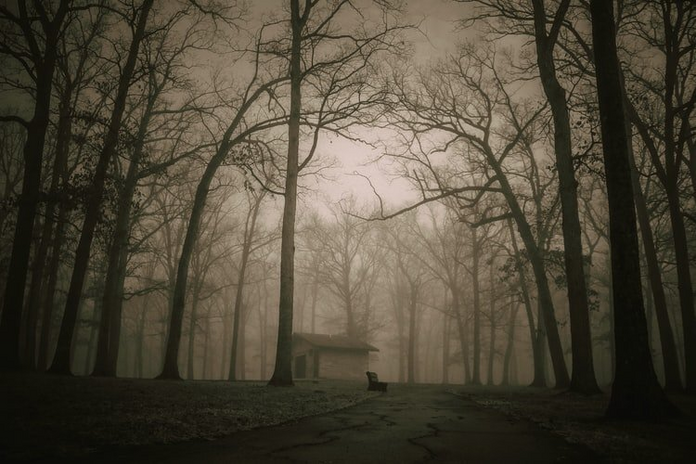Every October, I embark on the wildest and most treacherous journey of all: trying to convince as many people as humanly possible that Over the Garden Wall is worthy of being #1 on their cozy fall watchlist. I was simply born to undertake this task, and I carry out this mission with great pride. In Part 1 of this series, I laid the foundation of how this underdog of a Cartoon Network show garnered an autumn-addicted cult following. Here, I’ll begin to discuss why it is the most perfect fall show to ever exist: starting with its clever twist of nostalgic appeals.
In a style that can only be described as Brothers Grimm meets Adventure Time, Over the Garden Wall appeals to a nostalgia-craving audience by making a spectacle of distorted childlike themes. In this way, this show is perfect for both the mature child and the immature adult. Greg is symbolic of innocence and juvenility throughout the series, acting as both the Jester archetype with his humorous quips and the Child archetype with his curiosity and naivete. When he isn’t making a mess of things or trying to soothe his anxious elder brother, he can be found racking his brain for the funniest way to rename his beloved pet frog. The dialogue of the show actually begins with Greg conjuring up frog names, including “Salami, Giggly, Jumpy, Tom, Thomas, Tambourine, Leg-Face McCullen, Artichoke, Penguin, Pete, Steve…” before he is cut off by Wirt’s worrying. The audience wants nothing more than to protect and preserve the youthful kindness that Greg exudes. Child viewers can’t help but root for his success as the bumbling young underdog, and adult can’t help but see their past selves in him: Greg’s exaggeratedly trusting, hopeful view of the world is something older audiences yearn to go back to, and his childlike optimism is something they are nostalgic to revisit.
NOSTALGIA & MUSICAL ELEMENTS
The show is absolutely littered with what can only be described as twisted, haunting nursery rhymes. The instrumentals are often rich and dark, juxtaposed against childish and poetic lyrics (or vice versa). For example, the introduction song plays a hearty yet simple melody with deep and introspective lyrics: “How the gentle wind, /Beckons through the leaves, /As autumn colors fall. /Dancing in a swirl, Of golden memories, /The loveliest lies of all.” These lyrics are reflective of the show’s most prominent themes: autumn, innocence, dishonesty, nostalgia. The series also expertly makes use of diegetic music. In “Chapter 6: Lullaby in Frogland”, Greg gets so excited about the prospect of visiting someone who could possibly help them get back home, that he creates a song: “Oh, we’re going to the pasture to meet Adelaide and ask her if she has a way to send us back where we came from! / I don’t know who she is or how she is or when, what, why she is, but as for where she is, she is where we will go!”. The song is simple, upbeat, and reflective of Greg’s sheer joy to possibly leave The Unknown. However, he is unaware of the fact that Adelaide is actually someone who wishes to inflict serious harm on Greg and Wirt by enslaving them, since she exists at The Beast’s command. Every piece of youthful, comforting nostalgia within Over the Garden Wall often comes at the price of an underlying darker theme.
NOSTALGIA & SETTING
The universal nature of the mise-en-scene within this show makes it feel relatable and homey. There are two primary settings within Over the Garden Wall: The dark and confusing Unknown, versus Greg and Wirt’s “modern” home world on Halloween night, which is only finally introduced within the last two episodes. The Unknown is not some faraway and unachievable setting (such as Adventure Time’s technicolor, candy-coated Land of Ooo). The Unknown is just an untraceable forest within rural bygone America. It is universal, and any dark woods in any part of the United States will look just like it. Elements of the regency era, baroque architecture, and turn-of-the-century folksiness make The Unknown truly feel unknown and unpinnable to a single time period. Likewise, Greg and Wirt are donning bizarrely antiquated, pilgrim-like outfits throughout their journey, of which is offered no explanation— until the viewers find out they got lost in The Unknown on Halloween night and they actually are just in makeshift costumes.
When Greg and Wirt’s place of origin is finally revealed through a flashback in Chapter 9, the audience uncovers that, just like The Unknown exists on a timeless plane of existence, so does their home world. It pulls from universal archetypes of classic American youth activities— trick-or-treating, house parties, running gleefully in the streets, football games, collecting painted rocks— to create a sense of endless childhood that cannot be pinned down to a single time period. It is set in a cookie cutter, mundane suburbia. Since every visible character is wearing a Halloween costume in this Chapter, no time period can be assumed from clothing analysis. This feels deliberate, as though showrunner Patrick McHale wanted to mask and withhold context from the story to make it feel more like a fairytale: a story that exists only within a vacuum and unshackled to its historical context. I can’t help but draw a parallel to the most unassumingly heartbreaking Phoebe Bridgers lyrics:
“Baby, it’s Halloween /
And we can be anything /
… I’ll be whatever you want”.
To Bridgers, Halloween is a metaphor for the doomed faith that a dying relationship can persist for one more night–– if they can just put their silly little masks on and pretend everything is fine. In a similar way, Over the Garden Wall uses Halloween to further the theme of timelessness, symbolically “putting a mask” over any signifiers of time period. Because of its vague setting, Over the Garden Wall can truly be anything to the viewer. Its setting is so unique, yet so historically vague, that it invites viewers feel comfortable projecting their own lives onto this mundane fantasy dreamscape. It truly is whatever you want it to be.
Another example of the timeless ambiguity of the setting is the conservative mention of technology. The audience only knows that Wirt enjoys cassette tapes, yet others around him don’t seem to share this same passion; thus, it feels wrong to assume it is a time of peak cassette popularity. The viewer can go around and around with this type of assumption with nearly every aspect of their home world, and never find a definitive answer— yet somehow, this feels entirely intentional.
In sum: the mise-en-scene of Over the Garden Wall is unlabeled, timeless, and universally relatable to American youth, making it the perfect vessel for nostalgia and comfort.
NOSTALGIA & ANTAGONISTS
Though Greg and Wirt face several antagonists as they venture through The Unknown (such as Adelaide, Aunty Whispers, and the Old Mill Dog), these villains are all-too physical and human-adjacent to be actually horrifying. The true horror lies in the psychological fear inflicted by The Beast, who is an unrecognizable, intangible, God-like figure that exists only in shadows. He hopes to absorb all child travelers who venture through the woods by capturing their souls in a lantern that keeps himself alive, and turns their physical bodies into the edelwood trees that make up the forest. He preys on vulnerability, shame, and self sacrifice. This is a twist on the classic trope of children being afraid of the dark, and teaches that true horror and evil are intangible concepts: likewise, that childhood innocence is a rarity worth killing for. Essentially, this distorted sense of nostalgia is the driving force that makes this concept so horrifying to viewers.
ESSENTIALLY…
Over the Garden Wall lulls viewers into a false sense of security with rich elements of childhood and nostalgia, only to ever-so-slightly distort these symbols to build tension and discomfort. By masterfully tearing down the facade that innocence exists in an unreachable vacuum, Over the Garden Wall allows viewers feel at peace with the possibility that even the most tainted memories can still be fondly romanticized.


